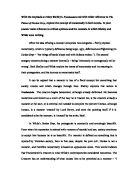McCarthy continually reminds us of the bleakness of the setting as the man and boy walk along. You can't go for more than two pages before reading something like, “Nights beyond darkness and the days more gray each one than what had gone before” (3). As readers, we only experience bright colors through the characters' dreams or memories, if someone happens to bruise or bleed, or through fire or flare guns. The rest of the time we see a gray ash covering the landscape. This provides very powerful and haunting imagery for the reader and places us directly into this lifeless and desolate world.
Another evocative aspect of the book that contributes to its gray nature is McCarthy’s poetic yet simplistic style of writing. His use of diction and syntax allows him to say a hundred things in one succinct sentence. The short pithy phrases and matter-of-fact style provide the reader with the bare facts, and nothing more. He says everything he needs to, but never too much. This leaves the reader with the freedom to illustrate the story as he or she moves through the book, and create his or her own world within The Road. Since the setting and the atmosphere are especially important this novel, McCarthy’s style of involving the reader’s imagination holds a lot of weight and has a huge effect:
The city was mostly burned. No sign of life. Cars in the street caked with ash, everything covered with ash and dust. Fossil tracks in the dried sludge. A corpse in a doorway dried to leather. Grimacing at the day. He pulled the boy closer. Just remember that the things you put into your head are there forever, he said. You might want to think about that (12).
Not only is the imagery in the scene clear and powerful, but he also raises questions in the reader’s mind that reach beyond the man and boy. The passage pulls one’s own dark side and gray nature into the story. McCarthy leaves room for people to fill the ominous and colorless void with their own ideas and fears of darkness and numbness… He is asking: What do you have stuck in your head that you wish you never did?
Finally, the dark epicenter of the novel is reinforced by the utter selfishness and lack of humanity that pervades the remainder of society; people turning on one another and reverting back to primal methods of survival of the fittest:
Behind them came wagons drawn by slaves in harness and piled with goods of war and after that the women, perhaps a dozen in number, some of them pregnant, and lastly a supplementary consort of catamites illclothed against the cold and fitted in dogcollars and yoked each to each. All passed on” (92).
These immoral nomadic groups pose a great threat and leave the man and boy with no sense of community or trust with anyone other than themselves. The sky is dark, the ground is ashen, and even common empathy between persons has grown cold and hollow. The gray condition of narcissism and emptiness has found its way into even the most sacred of places, the human soul. These people who have resorted to barbarous behaviors and hardened their hearts, have flushed all the color from their lives.
However, there is hope of “carrying the fire” onward. The boy does finally meet other people who have kept their humanity, kept their fire alive. This fire, the kind found within the self, is a symbol of everlasting hope and human resilience…the opposite of gray. Instead of succumbing to the circumstances and resorting to evil acts to survive, the boy carries the fire and does not compromise his higher human morality. No matter what horror they narrowly escape, the boy always seeks to help other individuals and never believes they should be hurt or punished, even if hurting others might ensure his own survival. It is with this choice, to overrun selfishness with love, that we flood our hearts with color and work towards a less gray society.
To the extent that the novel resonates with the real world, the message is the same: people like the boy always carry the fire. The truth, however, is that our world is shockingly similar the one in The Road, with far too many people seeming to choose self-preservation at the cost of genuine human concern for others. Our more complex world is not so simple as the tradeoff involved in killing others in order to survive, but McCarthy points out to us our human nature - the fire of human compassion is often extinguished when we encounter adversity.
The world McCarthy immerses us in with The Road, is one that we can all too easily relate to. Through his potent style and choice of setting he gives us the tools to vividly construct an ultimately gray landscape and fill it with our own personal demons. His message about humanity’s inhumanity also adds a layer that we can compare to our own society. In effect, he not only places us in the shoes of the man and boy, but also transports our individual selves into the desolate environment along side that infamous road.








